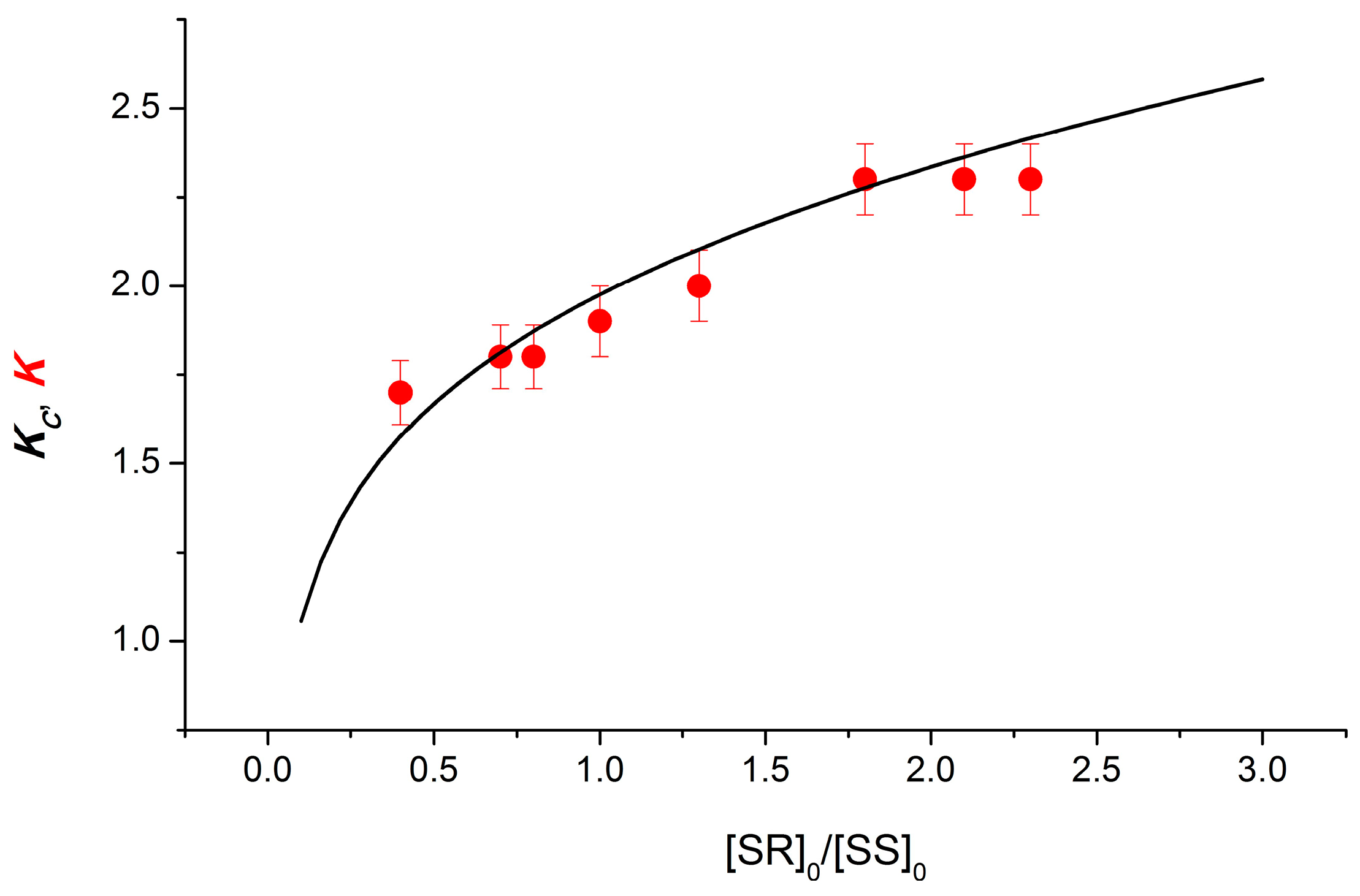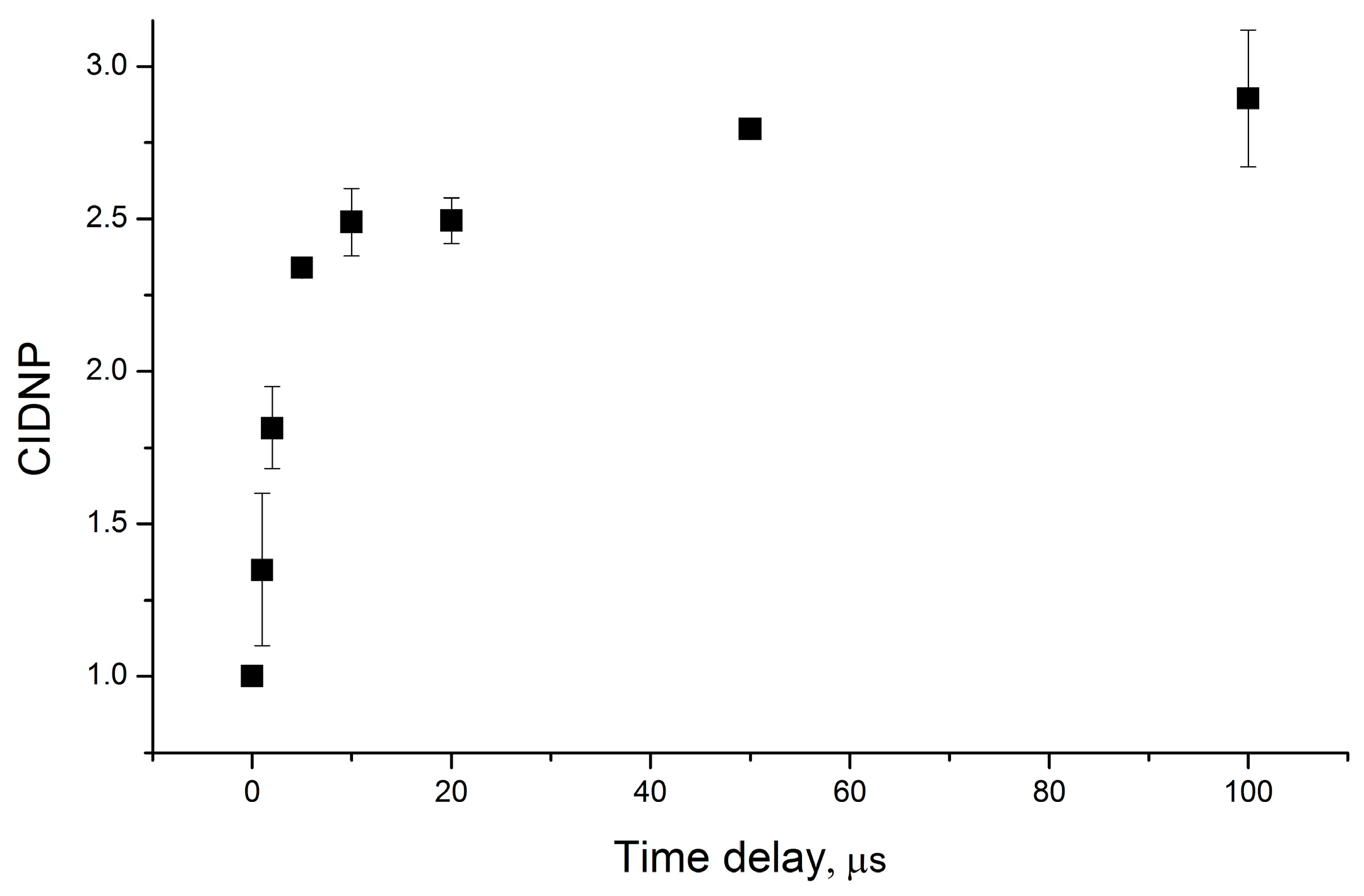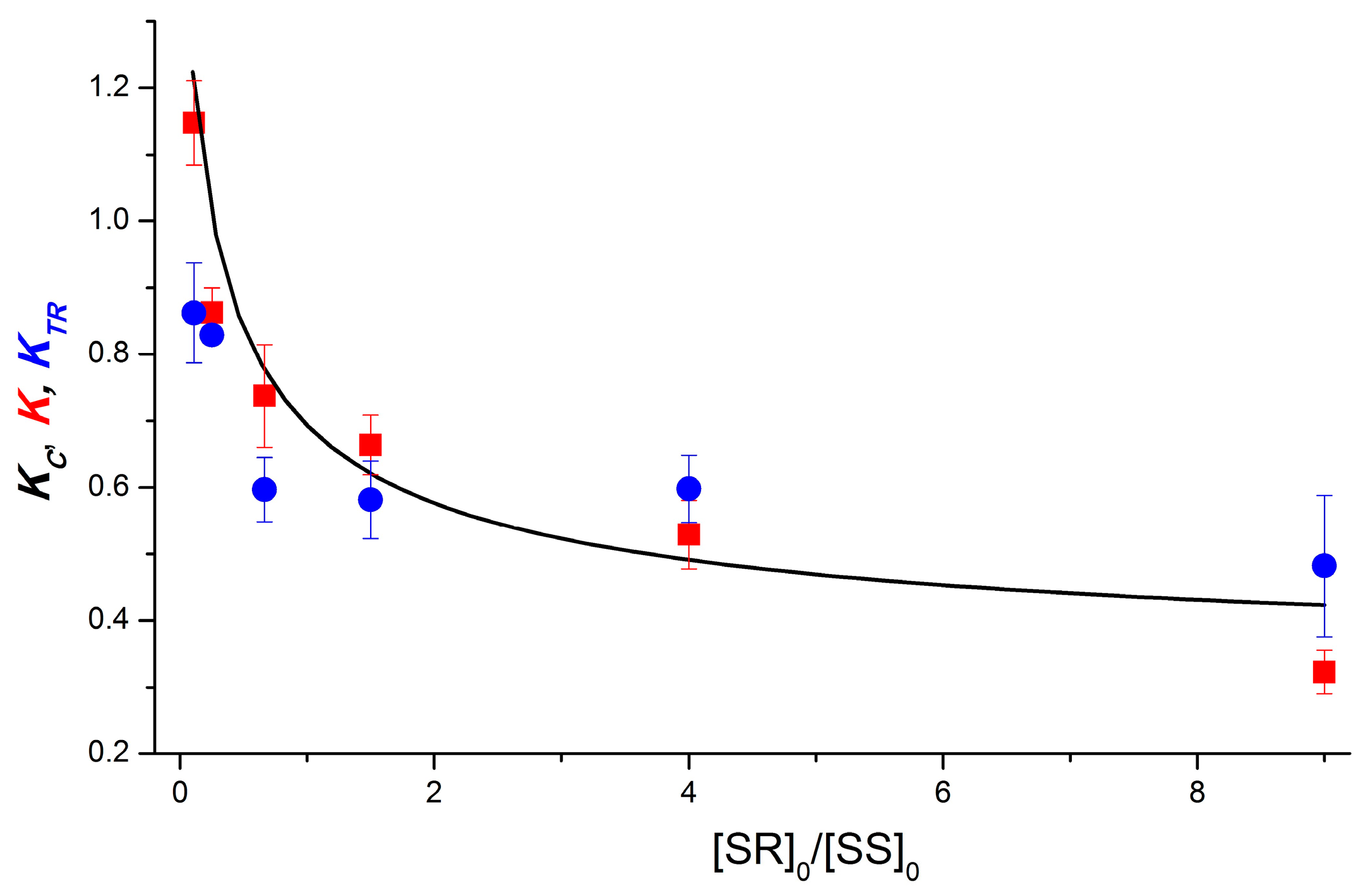Impact of Non-Covalent Interactions of Chiral Linked Systems in Solution on Photoinduced Electron Transfer Efficiency
Abstract
1. Introduction
2. Results and Discussion
2.1. Description of a Modified Approach to Calculate CIDNP Dependence on the Ratio of Diastereomer Concentrations
2.2. Dependences between the K and the Ratio of Dyad II Diastereomer Concentrations: Comparison of Experimental and Calculated Results
2.3. Dependences between the K Values and the Ratio of Dyad III’s Diastereomer Concentrations: Comparison of Experimental and Calculated Dependences
2.4. Influence of the Homo-, Heterodimer, and Monomer Contributions and Magnitudes of Dimerization Equilibrium Constants on the CIDNP Efficiency in ET
3. Materials and Methods
4. Conclusions
Supplementary Materials
Author Contributions
Funding
Institutional Review Board Statement
Informed Consent Statement
Data Availability Statement
Conflicts of Interest
Abbreviations
| CIDNP | Chemically induced dynamic nuclear polarization |
| ET | Electron transfer |
| EE | Electron degenerate exchange |
| BZ | Biradical zwitterion |
| NSAID | Non-steroidal anti-inflammatory drug |
| PET | Photoinduced electron transfer |
References
- Zheng, Y.; Mao, K.; Chen, S.; Zhu, H. Chirality Effects in Peptide Assembly Structures. Front. Bioeng. Biotechnol. 2021, 9, 703004. [Google Scholar] [CrossRef] [PubMed]
- Roy, S.; Giri, R.; Dolai, G.; Mandal, B. Role of side-chain and chirality of the amino acids on the supramolecular assemblies of dipeptides. J. Mol. Struct. 2020, 1221–1287, 128877. [Google Scholar] [CrossRef]
- Wang, X.; Gan, H.; Sun, T. Chiral Design for Polymeric Biointerface: The Influence of Surface Chirality on Protein Adsorption. Adv. Funct. Mater. 2011, 21, 3276–3281. [Google Scholar] [CrossRef]
- Qing, G.Y.; Zhao, S.L.; Xiong, Y.T.; Lv, Z.Y.; Jiang, F.L.; Liu, Y.; Chen, H.; Zhang, M.; Sun, T. Chiral effect at protein/graphene interface: A bioinspired perspective to understand amyloid formation. J. Am. Chem. Soc. 2014, 136, 10736–10742. [Google Scholar] [CrossRef]
- Childers, M.C.; Towse, C.L.; Daggett, V. The effect of chirality and steric hindrance on intrinsic backbone conformational propensities: Tools for protein design. Protein Eng. Des. Sel. 2016, 29, 271–280. [Google Scholar] [CrossRef]
- Raskatov, J.A.; Teplow, D.B. Using chirality to probe the conformational dynamics and assembly of intrinsically disordered amyloid proteins. Sci. Rep. 2017, 7, 12433. [Google Scholar] [CrossRef]
- Zerze, G.H.; Stillinger, F.H.; Debenedetti, P.G. Effect of heterochiral inversions on the structure of α-hairpin peptide. Proteins 2019, 87, 569–578. [Google Scholar] [CrossRef]
- Hou, K.; Zhao, J.; Wang, H.; Li, B.; Tang, Z. Chiral gold nanoparticles enantioselectively rescue memory deficits in a mouse model of Alzheimer’sdisease. Nat. Commun. 2020, 11, 4790. [Google Scholar] [CrossRef]
- Khan, S.; Iqbal, S.; Taha, M.; Rahim, F.; Shah, M.; Ullah, H.; Bahadur, A.; Alrbyawi, H.; Dera, A.A.; Alahmdi, M.I.; et al. Synthesis, In Vitro Biological Evaluation and In Silico Molecular Docking Studies of Indole Based Thiadiazole Derivatives as Dual Inhibitor of Acetylcholinesterase and Butyrylchloinesterase. Molecules 2022, 27, 7368. [Google Scholar] [CrossRef]
- Chiellini, G. Understanding Amyloid Structures and Disease: A Continuing Challenge in Health Research. Int. J. Mol. Sci. 2021, 22, 6620. [Google Scholar] [CrossRef]
- Ageeva, A.A.; Doktorov, A.B.; Selyutina, O.Y.; Magin, I.M.; Ilyina, M.G.; Borisevich, S.S.; Rubtsov, R.Y.; Khursan, S.L.; Stepanov, A.A.; Vasilevsky, S.F.; et al. Optical Configuration Effect on the Structure and Reactivity of Diastereomers Revealed by Spin Effects and Molecular Dynamics Calculations. Int. J. Mol. Sci. 2022, 23, 38. [Google Scholar] [CrossRef]
- Ageeva, A.A.; Khramtsova, E.A.; Magin, I.M.; Rychkov, D.A.; Purtov, P.A.; Miranda, M.A.; Leshina, T.V. Spin Selectivity in Chiral Linked Systems. Chem. Eur. J. 2018, 24, 3882–3892. [Google Scholar] [CrossRef]
- Ageeva, A.A.; Khramtsova, E.A.; Magin, I.M.; Purtov, P.A.; Miranda, M.A.; Leshina, T.V. Role of Association in Chiral Catalysis: From Asymmetric Synthesis to Spin Selectivity. Chem. Eur. J. 2018, 24, 18587–18600. [Google Scholar] [CrossRef]
- Barry, B. Reaction dynamics and proton coupled electron transfer: Studies of tyrosine-based charge transfer in natural and biomimetic systems. Biochim. Biophys. Acta 2015, 1847, 46–54. [Google Scholar] [CrossRef] [PubMed]
- Ivanov, K.; Yurkovskya, A.; Fishman, N.; Kiryutin, A.; Sagdeev, R.Z.; Vieth, H.-M. Chemically Induced Spin Hyperpolarization: Coherence Formation in Reaction Products. Appl. Magn. Reson. 2022, 53, 595–613. [Google Scholar] [CrossRef]
- Frank, F.C. On spontaneous asymmetric synthesis. Biochim. Biophys. Acta 1953, 11, 459–463. [Google Scholar] [CrossRef] [PubMed]
- Ageeva, A.A.; Babenko, S.V.; Magin, I.M.; Plyusnin, V.F.; Kuznetsova, P.S.; Stepanov, A.A.; Vasilevsky, S.F.; Polyakov, N.E.; Doktorov, A.B.; Leshina, T.V. Stereoselectivity of Electron and Energy Transfer in the Quenching of (S/R)-Ketoprofen-(S)-Tryptophan Dyad Excited State. Int. J. Mol. Sci. 2020, 21, 5370. [Google Scholar] [CrossRef]
- Ageeva, A.A.; Magin, I.M.; Doktorov, A.B.; Plyusnin, V.F.; Kuznetsova, P.S.; Stepanov, A.A.; Alekseev, A.A.; Polyakov, N.E.; Leshina, T.V. Role of Chiral Configuration in the Photoinduced Interaction of D- and L-Tryptophan with Optical Isomers of Ketoprofen in Linked Systems. Int. J. Mol. Sci. 2021, 22, 6198. [Google Scholar] [CrossRef]
- Ageeva, A.A.; Doktorov, A.B.; Polyakov, N.E.; Leshina, T.V. Chiral Linked Systems as a Model for Understanding D-Amino Acids Influence on the Structure and Properties of Amyloid Peptides. Int. J. Mol. Sci. 2022, 23, 3060. [Google Scholar] [CrossRef]
- Riese, S.; Brand, J.; Mims, D.; Holzapfel, M.; Lukzen, N.; Steiner, U.; Lambert, C. Giant magnetic field effects in donor–acceptor triads: On the charge separation and recombination dynamics in triarylamine–naphthalenediimide triads with bis-diyprrinato palladium(II), porphodimethenato-palladium(II), and palladium(II)–porphyrin photosensitizers. J. Chem. Phys. 2020, 153, 054306. [Google Scholar] [CrossRef]
- Mc Caslin, T.; Pagba, C.; Chi, S.; Hwang, H.J.; Gumbart, J.C.; Perry, J.W.; Olivieri, C.; Porcelli, F.; Veglia, G.; Guo, Z.; et al. Structure and Function of Tryptophan−Tyrosine Dyads in Biomimetic β Hairpins. J. Phys. Chem. B. 2019, 123, 2780–2791. [Google Scholar] [CrossRef] [PubMed]
- Soai, K.; Kawasaki, T.; Matsumoto, A. Asymmetric autocatalysis of pyrimidyl alkanol and related compounds. Self-replication, amplification of chirality and implication for the origin of biological enantioenriched chirality. Tetrahedron 2018, 74, 24–35. [Google Scholar] [CrossRef]
- Pachao, Y.; Zhang, Z.; Lv, H.; Li, T.; Haso, F.; Hu, L.; Zhang, B.; Bacsa, J.; Wei, Y.; Gao, Y.; et al. Chiral recognition and selection during the self-assembly process of protein-mimic macroanions. Nat. Commun. 2015, 6, 6475. [Google Scholar] [CrossRef]
- Khramtsova, E.A.; Ageeva, A.A.; Stepanov, A.A.; Plyusnin, V.F.; Leshina, T.V. Photoinduced Electron Transfer in Dyads with (R)-/(S)-Naproxen and (S)-Tryptophan. Z. Phys. Chem. 2017, 231, 609–623. [Google Scholar] [CrossRef]










| Dyad | KSS,SS, M−1 | KRS,RS, M−1 | KRS,SS, M−1 | αRS | αSS | βRS-SS | βSS-RS | γ |
|---|---|---|---|---|---|---|---|---|
| I | 2 × 105 | 2 × 105 | 1 × 105 | 2.0 | 1.0 | 0.1 | 0.1 | 0 |
| II | 2 × 105 | 2 × 105 | 2 × 105 | 1.8 | 1.0 | 1.6 | 5.5 | 0 |
| III | 2 × 103 | 50 | 5 × 104 | 1.0 | 1.8 | 3.0 | 2.0 | 2.0 |
Disclaimer/Publisher’s Note: The statements, opinions and data contained in all publications are solely those of the individual author(s) and contributor(s) and not of MDPI and/or the editor(s). MDPI and/or the editor(s) disclaim responsibility for any injury to people or property resulting from any ideas, methods, instructions or products referred to in the content. |
© 2023 by the authors. Licensee MDPI, Basel, Switzerland. This article is an open access article distributed under the terms and conditions of the Creative Commons Attribution (CC BY) license (https://creativecommons.org/licenses/by/4.0/).
Share and Cite
Magin, I.M.; Pushkin, I.A.; Ageeva, A.A.; Martianova, S.O.; Polyakov, N.E.; Doktorov, A.B.; Leshina, T.V. Impact of Non-Covalent Interactions of Chiral Linked Systems in Solution on Photoinduced Electron Transfer Efficiency. Int. J. Mol. Sci. 2023, 24, 9296. https://doi.org/10.3390/ijms24119296
Magin IM, Pushkin IA, Ageeva AA, Martianova SO, Polyakov NE, Doktorov AB, Leshina TV. Impact of Non-Covalent Interactions of Chiral Linked Systems in Solution on Photoinduced Electron Transfer Efficiency. International Journal of Molecular Sciences. 2023; 24(11):9296. https://doi.org/10.3390/ijms24119296
Chicago/Turabian StyleMagin, Ilya M., Ivan A. Pushkin, Aleksandra A. Ageeva, Sofia O. Martianova, Nikolay E. Polyakov, Alexander B. Doktorov, and Tatyana V. Leshina. 2023. "Impact of Non-Covalent Interactions of Chiral Linked Systems in Solution on Photoinduced Electron Transfer Efficiency" International Journal of Molecular Sciences 24, no. 11: 9296. https://doi.org/10.3390/ijms24119296
APA StyleMagin, I. M., Pushkin, I. A., Ageeva, A. A., Martianova, S. O., Polyakov, N. E., Doktorov, A. B., & Leshina, T. V. (2023). Impact of Non-Covalent Interactions of Chiral Linked Systems in Solution on Photoinduced Electron Transfer Efficiency. International Journal of Molecular Sciences, 24(11), 9296. https://doi.org/10.3390/ijms24119296









